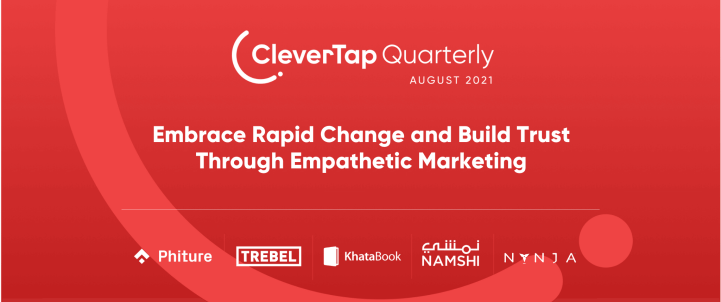From time spent in mobile apps to revenues generated, metrics for mobile apps continue to climb as record numbers of consumers lean into mobile and apps to do regular tasks such as shopping and managing their daily routine. Lockdown and now reopening have transformed retail, packing “a decade of ecommerce growth into a single year.”
Global events have also changed conditions and expectations for most professionals, triggering the move to hybrid work. In this scenario, digital and mobile platforms empower more traditional workers to explore new, flexible career options. They also combine as the catalyst for a new phase in the “freelance revolution,” where agility tops the list of priorities for companies and contract workers alike.
Whether you’re a marketplace adapting to the changing needs of consumers or a communications-platform provider accommodating the individual needs of remote workers, a strategy focused on retention and keeping users loyal longer pays dividends.
To help you develop the right blueprint for your business, we have organized the top advice and industry observations from a panel of marketing experts who spoke at our most recent CleverTap Quarterly.
CleverTap Quarterly: August 2021
CleverTap Quarterly is the high-caliber virtual event we organize with leading customers, retention specialists, and industry authorities to share proven strategies and surprising growth hacks.
The session titled “Prepare for Impact: How Leading Marketers Have Adapted to Rapid Change for Amazing Results,” brought together:
- Anannya Roy Sen, Head of Marketing at Namshi, an ecommerce platform headquartered in Dubai, and
- Timothy Calise, COO, Nynja, an all-in-one communication platform tailored to the needs of freelancers and free agents globally.
- It was moderated by Peggy Anne Salz, mobile marketing influencer, Forbes Senior Writer, and founder of MobileGroove).
Check it out on our YouTube page or click play below.
#1 Listen to Signals to Adjust Personalization Strategies
Effective personalization is granular. But following the pandemic, commerce companies also had to inject a new element into the mix: empathy. It was all about understanding how consumer needs evolved over time, and it was critical to draw from the data to understand the appropriate moments and context to deliver marketing.
“You can’t just be sending out promotional communications to your customers,” Sen explained. As a marketer, you also had to ask yourself some important questions. “Should we just keep selling what we keep selling, or should we just engage with them to understand if they’re having a bad day or a good day?”
This is where no commerce company has the right answers, but it’s where a new approach to data can help, Sen said. “It started off by understanding how we can enrich our CRM platform to send back the right signals… to customize my communications.”
In the case of Namshi, this meant drawing from the data and signals around “at least six to seven transactions” to understand the customer better. Knowing how shopper behavior evolved over this period shed important light on how and when to cross-sell or upsell.
A similar approach allowed NYNJA to optimize its product – and marketing – to accommodate the needs of a new global freelancer network. The quick acceleration to work-from-home and project-based work required a very quick kind of pivot to “understanding very clearly what the user behaviors were, around this new normal,” Calise explained. It also demanded a holistic approach, one that united departments and data to serve the customer better. “There was the acquisition side, there was the user experience and customer success, and then the development experience as well, and all three informed each other.”
#2 Leverage Data to Build Customer Loyalty
Adjusting strategies and internal team structures to adapt marketing and messaging to rapid change is one thing. But marketers also have to take a similar approach to align offers more closely with sudden shifts in user behavior.
This is what happened when Namshi noticed that consumers became more price-sensitive, as the pandemic progressed. When it first hit, there was no time to change the pricing strategy. But, as data and signals made it clear that fashion wasn’t as essential as groceries, Namshi could shift its communications strategy to adapt to the shift in priorities.
“Consumers wanted more value for the money they were spending on fashion. So that led to us understanding how do we promote our wider inventory?” Rather than continue to focus on top brands in marketing communications, the strategy changed to “talk about other brands that were probably more economical for our users without compromising on the quality of products.”
The learning is constant because change is also constant, Sen said. As consumers in each market behave differently and have different needs, Namshi has evolved strategies that suit each. “Every single thing has to be customized now; it’s not one-size-fits-all.” Her advice: “You really need to enrich the signals that [you] pass back into the platform so that [you] continue to stay relevant to consumers in each of these markets.”
#3 Put the Customer First, Over Performance
Driving the first purchase is important, but retention is the prize. It’s all about “taking a step back to understand: ‘How do we send across the right communication to the consumers without being super pushy and get them to make the second transaction?’” Sen explained.
It’s an easy exercise – provided the user experience with the product is a good one.
Delivering an excellent customer experience requires marketing and product to focus on providing value. In the case of Namshi, it also resulted in new value propositions such as enabling consumers to buy now and pay later. “It was just one of a number of initiatives that was taken across the organization to be able to keep ourselves relevant to our target consumers.”
Messaging must also be relevant. To this end, Namshi continuously tests to understand what kind of communications leads to more open rates for CRM communications. “That is one of the signals that we use to understand how we continue to customize messaging for our consumers,” Sen said. It also allows her team to answer critical questions that can help or harm retention rates. “Very simple things like should I continue to [send customers] retargeting ads whenever there is a price drop off?”
Which messaging should be prioritized? Sen said there is no clear answer. But there is a clear path. “It’s been a long journey about enriching the signals that we pass on to our CRM tools… and working on our CRM tools to pass on a lot of additional data points, to understand a lot more details about the consumer to be able to work on our retention journeys.” It’s also the only workaround in a market where audience data and identifiers are limited.
“Performance marketing is changing drastically,” Sen explained, and that turns up the pressure on marketers to focus on CRM. “Organic is much more valuable now because gone are the times when you can pump in money into performance marketing and expect results to show up. So this is the new reality for me.” The solution: “We just need to get better with how we identify our consumers and be able to service them better.”
#4 Remove the Grit, Make the Experience Great
Your customer is in control, and they know what they want. “We live in a world where I want to have what I need effectively when I need it in the way that I need it.” That means providing experiences that are “curated for customer segments.” It also means providing an experience that feels frictionless.
It’s about harnessing data to find ways to “remove the grit from the process,” Calise said.
He even proposed a formula for marketers to follow. “From an equation perspective, it’s the speed-to-value divided by the amount of grit. So if I can get a piece of value delivered today with no other kind of friction, that’s almost like infinity. It’s like dividing by zero, effectively.”
Organizing to deliver this level of value is an ambitious goal. But it’s also a worthwhile pursuit for companies determined to drive relevance and retention in times of rapid change.
Watch the CleverTap Quarterly Recording
For the complete experience, we have the complete playlist of every session at the August 2021 CleverTap Quarterly.
Check out our YouTube channel for more.

Subharun Mukherjee 
Heads Cross-Functional Marketing.Expert in SaaS Product Marketing, CX & GTM strategies.
Free Customer Engagement Guides
Join our newsletter for actionable tips and proven strategies to grow your business and engage your customers.















































